Thus, it's not a surprise I've been hit pretty hard by the news of the earthquake, tsunami, nuclear power plant problems, and mounting casualty list. The more I read about it, the more I see the pictures of the damage, the more nauseous I feel whenever I think about it. Early today I realized that many people didn't have the personal experiences that I did, and that they were seeing the devastation and that might be the image of Japan that was lodging in their minds. So, to help me process my own feelings, I thought I'd put together a post with some of the best pictures I took while I was there, so that everyone less familiar with the country can get to see a glimpse of the Japan that I know and love. Though a long post, this is only a small selection of the shots I took there - though I was only just getting in to photography then, and I wasn't very good by my current standards. If you'd like to see more, the collection of the images I took on Flickr is here.

Tokyo is a city jammed with people and lit by lights. Unlike many cities (like New York), Tokyo doesn't have one center, it has several, and they're not all close together - many are miles and miles apart. All of these centers have names, and most are united by a loop train called the Yamanote line. This is a shot of Shibuya, where I only visited once.
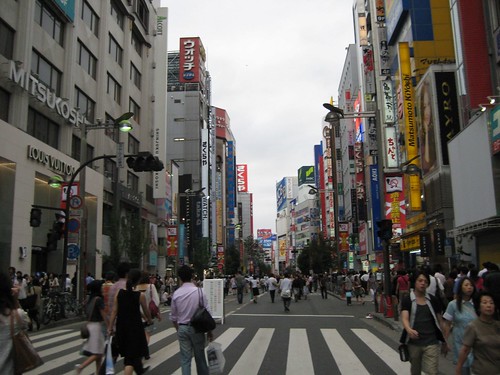
My favorite of the city centers was Shinjuku. On the weekends, they close the streets to traffic, and people fill the streets. Buskers perform (next to a sign that says no buskers allowed!) and frequent all the high-end stores. I went to Shinjuku a lot, for various reasons, like to pay my rent, or to go to the Kinokuniya there which had a good selection of books in English, but I never left without indulging my love of mochicreams, indescribably delicious frozen treats - like mochi but so much better - which I could buy just outside the train station.
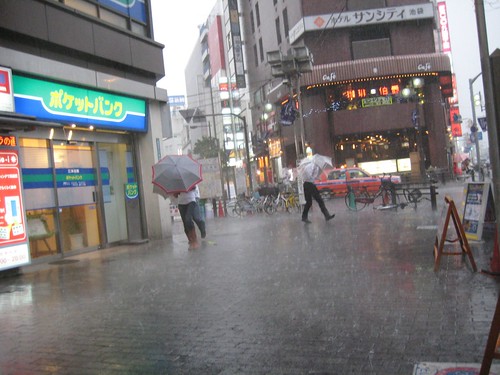
Ikebukuro was another of my favorites. It was home of the greatest used doujinshi store I've ever seen. Like a candy store for self-published manga fans. I ended up getting completely soaked this day (it wasn't raining when I got on the train, so I didn't have an umbrella ;) )
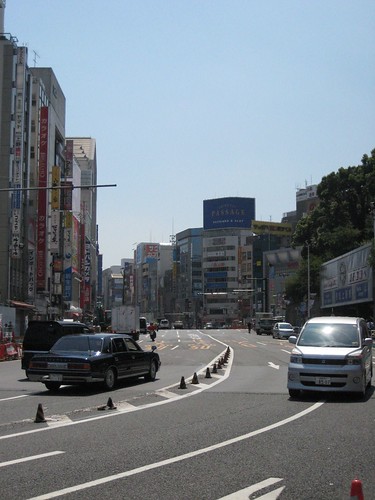
The closest city center to where I lived was Ueno. I took this photo my very first full day in Japan, with the station and Ueno Park on the right, and the shops on the left, and the road leading to Akihabara, which became a major haunt of mine. Any time I wanted to go anywhere, I would walk the mile from my apartment to the Ueno train station. I walked SO MUCH when I was in Tokyo; once, I walked all the way from my apartment to Shinjuku and back - 15 miles in total.
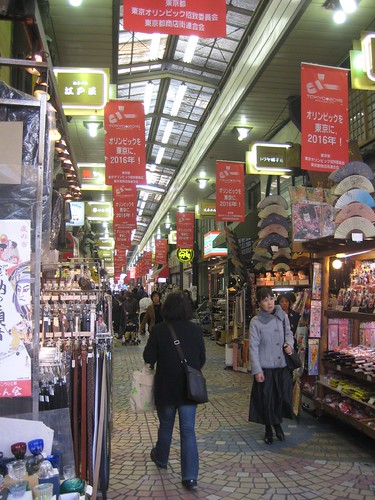
A mile in the other direction from my apartment was an area called Asakusa. Historically, Asakusa was the traditional "low town," where the poor and working classes lived in the 17th, 18th, and 19th century and served the court. At that point in time, as much as a half million people lived in that small area, but it was leveled flat by an earth quake in the late 19th century, then again by the great Kanto earthquake in 1923 which killed more than 100,000 people, and then a third time by the Allies fire-bombing during World War 2, and so it's much less populace now. There are a bunch of streets in Asakusa that are covered and filled with over priced stalls and shops that cater to the tourist trade.
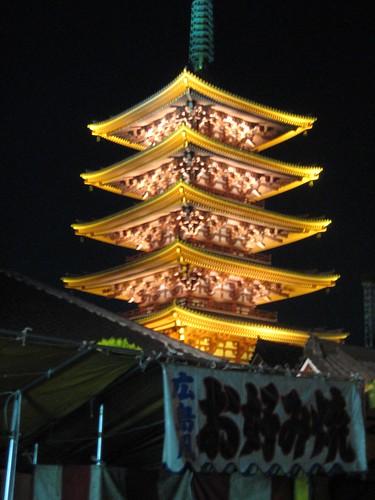
Asakusa is a major tourist destination because of Senso-ji (ji means temple). I would wander that neighborhood a lot, I loved it around there. Like most historical buildings in Tokyo, the original Senso-ji - built in the 8th or 9th century if memory serves - has been destroyed and rebuilt repeatedly. There is only one tori gate on the whole complex that dates from the original construction. The current version, like most "historical" buildings in Tokyo, is a concrete reconstruction meant to stand up to whatever comes.

I lived in a neighborhood called Matsugaya. The streets were quiet, mostly two story one family buildings, some broken in to apartments, others with business in the ground floor.

I lived in this one. There was a carpenter across the street, and a man who started work early every morning who would walk down the street singing Japanese opera. Every few days a car came around making a loud announcement that I never quite deciphered, and people would come round in cars and shout that you could buy fresh yakitori or other food from them (but I never actually got any!) At the end of the street was a tori that, when I first arrived, was the only landmark that I was able to use to find my apartment in the maze of similar-looking streets. Tokyo is VERY hard to navigate, and the atlas I bought of the city is the single most useful travel book I've ever had, anywhere. I mean, even more invaluable than a London A - Z. :)
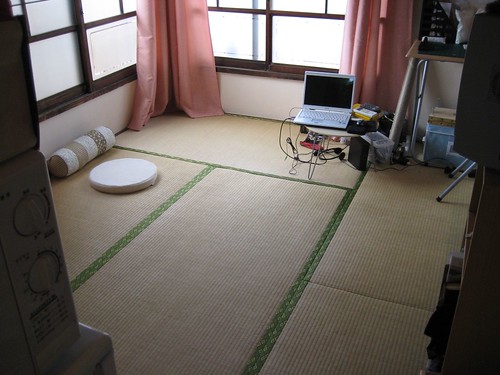
This is my entire apartment. It was around 150 sq. ft. I had to fold the futon up every morning and pull it out every night; sometimes I aired it out the windows, which slid open. The tatami mats smelled like heaven, and I dream even now of having a room in my home where I can just lie on the tatami and soak up the wonderful smell. I never would have thought I could be happy in so little space, but I was. Even in late fall, when my little heater couldn't get my room above 55 degrees at night, I was still happy (and I've had much better cold resistance ever since then ;) ). I was in this apartment when a typhoon hit, and I felt two different earthquakes while I was there (the first time it happened I thought it was my downstairs neighbors doing something best left implied, until I realized how ridiculous that was).

I spent a lot of time just wandering the city, and I grew to adore walking and exploring while I was there. On one of those days, I ended up walking 20 miles, including south down to the Rainbow Bridge. I was terrified of crossing the bridge (it's a phobia of mine), but I mustered my courage. It was worth it - it afforded some gorgeous views of Odaiba, a city center built on reclaimed land and home to an amusement park, a science museum, and loads of other neat stuff. For all that, it was kind of strange though.

The Odaiba ferris wheel is probably the most popular site there. The views when you are up in it are amazing. This is one of the first photographs I ever took with a deliberate eye towards trying to make in all artsy and interesting. :)

Food is one of the things I loved about Japan, and that I miss most. I loved to go was Tsukiji. Every morning at around 5 am, fresh fish are brought in to Tsukiji and served throughout the day to tourists who want to experience the freshest sushi in the world. It's not expensive, and it's absolutely delicious. I've never had sushi that compared. At one of the places I tried, they served me a bowl of Miso that I was shocked to discover these shrimp heads at the bottom.
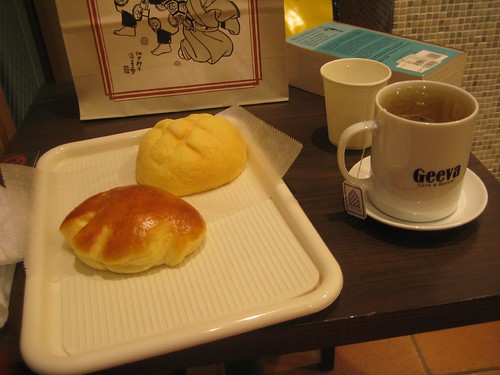
Every two or three days, I would walk to Cafe Geeva to buy fresh bread (in the bag in the back left) and I'd sit and read, drink jasmine tea, and eat Melon Bread of Cream Bread. I've looked and looked but I can find only facsimiles of my favorite foods from Japan. I've found mediocre melon bread in New York, and I found a place with mediocre cream bread the last time I went to Paris, but it's just not the same. And I've never found anything like the regular sliced bread, either - though just Thursday, I was in Flushing and saw some bread that looks suspiciously similar; I can't wait to buy some and try it and find out. I miss the mochicreams so much that when my oldest friend went to Japan last year I told him that all I wanted was for him to some how find a way to bring me mochicreams home. God bless the man, he bought me a dozen mochicreams and a thing of dry ice and carried them home on the plane in an insulated bag. They were just as good as I remembered. The only thing I've found a reasonable version of locally is kitsune udon, which is a noodle soup. Yum...
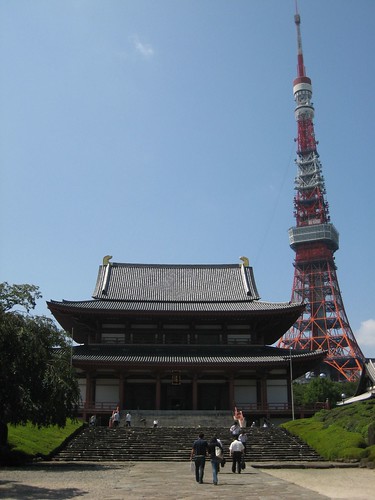
Tokyo is a constant contrast between old and new. I took a lot of shots that highlighted that contrast, but I went with this one because this is a stereotypical shots - one of the most common tourist shots of the entire city, and it's why people visit this temple, just so they can take a picture of both the temple and Tokyo Tower.
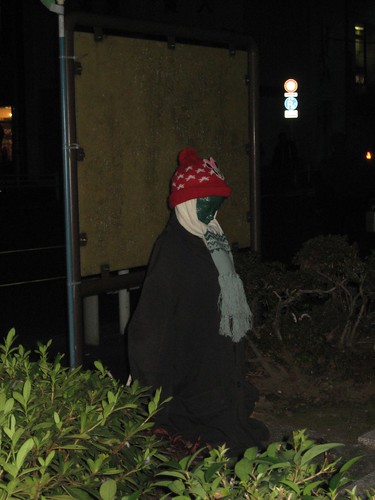
In addition to the big temples, there are little shrines all over this city. Many shrines relate to children, and the dressing of child shrines is considered a duty. I don't know enough about the religion to explain more fully, though.
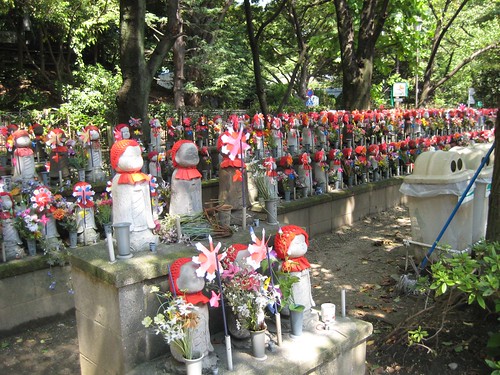
At some temples, there are even entire sections dedicated to the children shrines. These represent the souls of children who died, and every single outfit is hand made, and the flowers are always kept fresh. When the wind blows, all of the pinwheels go round and round.
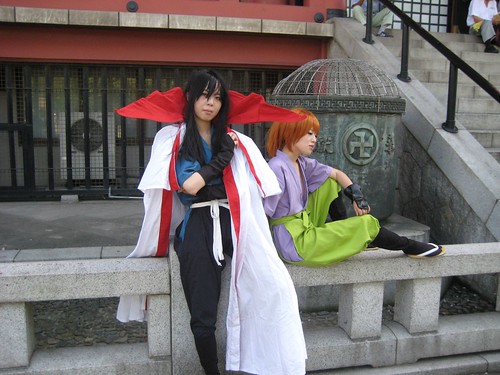
But in the end, it's the people who make Japan. The people who can sit on the seat of an ancient shrine (that's Senso-ji in the back) dressed as Hiko and Kenshin from Rurouni Kenshin, without a qualm. The people who throng through Shibuya, the two million+ people who pass through Shinjuku station every day. It's a vibrant place filled with life.

Very little has survived the rounds of destruction that have hit the city. There are virtually no buildings that have, only a few small structures. But at Hama-Rikyu Garden - which used to be a hunting ground for the shoguns - there is a pine tree that has survived for 300 years. And as I think about what's happened there, I just hope that this tree has survived. Because in the end, as long as life has been preserved, there is hope, and a future. Tokyo, and Japan, has rebuilt before, and it will rebuild again.
I know this post got very long, but for anyone who has stuck with me, I hope that these images of Tokyo help to show you another side of this wonderful country, not just the destruction filling the news. Please, consider doing what you can to help. Even a dollar can help to feed or medicate someone who has lost everything. Me, I'll be donating money and food to charity. I wish I could go there to help, but I just can't miss work.
No comments:
Post a Comment